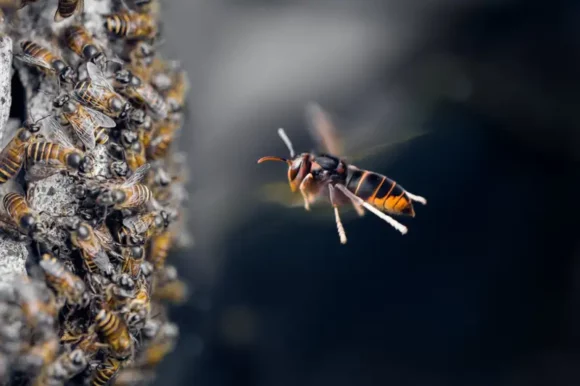Reading Seirian Sumner’s Endless Forms: The secret world of wasps, 25 May 2022
“It is almost impossible to walk into a bookshop these days and not bump into a beautiful book about bees,” Seirian Sumner grumbles. The London-based behavioural ecologist has, like the rest of us, reached “peak bee”. What are bees, anyway, but merely wasps that have forgotten how to hunt? The ‘original bee’ was a solitary wasp who turned vegetarian, just as the ‘first ant’ was a wasp that lost its wings.
Wasps are where the scientific action is: why, there are probably more distinct species of wasp than there are beetles! Did you know that there are swarming wasps in South America that build colonies “that look like air balloons, exotic fruits, gourds, cowpats, lumps of mud, Roman vases and even chamberpots?” That the study of wasp venom is helping us understand the more severe symptoms presented by COVID-19? That the familiar yellowjacket Vespula which terrorises our picnics can discriminate between similar-looking human faces?
Wait.
What…?
Seirian Sumner dares us to pause in wonderment. Behold the hyperparasitoids: micro-wasps that live on other parasitoid wasps, that live inside caterpillars, eating them from the inside out!
Savour the chemical cocktail of toxins, enzymes and amines with which the solitary hunting wasp simultaneously paralyses, cleanses and preserves prey fifteen times its body weight, “a helpless but healthy sack of living nutrients”! Admire her gleaming weaponised ovipositor!
The odd thing about wasps is not that we steer clear of them; it’s that we’ve learned so recently to ignore them. Much of the foundational learning offered up in this dense, anecdotal, intermittently stomach-churning labour of love is drawn from researchers active at the end of the nineteenth century. These people were even tougher-minded than Sumner. (“What lessons can we not learn from her transcendental chemistry?” exclaimed Leon Dufour, contemplating a wasp’s suspiciously fresh-looking weeks-old beetle victims. “How immensely superior to our own pickling-processes is that of the wasp!”)
With a level of glee last evinced by the kid at camp who urged you to put your hand in that hollow tree trunk, Sumner guides us through the evolution of hymenopteran sociality. Wasp societies represent the first stages in the evolution of altruism. Most small-colonied wasps follow a simple rule of succession: the older you are, the closer you come to being crowned queen. In more complex wasp societies, aggression is the norm, as rival nestmates bite and sting each other to death. This correlation between social complexity and violence is not reassuring. I now find myself looking askance at those highly social bees.
Endless Forms is an exuberant, garrulous, generous survey of its field. I can’t wait to read selected passages to my children.

